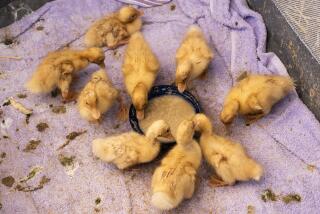Bird Lovers Go Bonkers for Honkers : Migratory fowl: Canada geese have returned to the Valley to forage, delight wildlife lovers--and perhaps cause aircraft pilots to be a little warier.
- Share via
They come to the San Fernando Valley for the same reason people originally did--warm weather and bountiful agricultural land.
They create such a raucous noise overhead that they’ve earned the nickname “honker” and travel in such dense flocks that they are considered a flight hazard for aircraft at Van Nuys Airport.
Canada geese descend upon the Valley and other areas of Southern California every winter, long black and white necks outstretched in V-flight formations of military precision.
The geese are back by the hundreds this winter--although experts say there are only about half as many as in the recent past--to the delight of their fans, preserving a touch of unfettered wilderness in an increasingly urban area.
Canada geese, the most common wild geese in North America, make their summer homes in a vast arc that stretches across the Northern Hemisphere from eastern Greenland west to the Kuril Islands off Japan. They fly south each winter, protected by the Migratory Bird Treaty involving the United States, Canada, Mexico and Great Britain.
Several flocks regularly arrive in late autumn to spend the winter in the Valley, shuttling between reservoirs, the flood plain behind Sepulveda Dam and shrinking farmland, where they scavenge for grain and grass.
A Dec. 15 census of all birds in the Valley by the Audubon Society counted 1,400 of the waterfowl. Experts say the number is down from the usual 3,000 birds because the region’s lingering drought has reduced the amount of available forage.
Many of the geese spend their winter days on the sprawling fields surrounding Pierce College in Woodland Hills, where they are so plentiful that Ted Kinchloe has integrated them into his bird identification class as a “natural living laboratory.”
They regularly fly over the house of Doris Bradshaw of Tarzana, who runs out to count them whenever she hears the approaching din of the flock. She estimated that 1,000 geese swooped over her roof years ago--about five Vs of 200 geese each--on their way to nearby Sepulveda Dam.
“You wouldn’t believe it,” she said. “It’s a very primitive, earthy sound. . . . As we’re struggling on with our problems of environmental pollution, these geese remind me that the environment will go on.”
The big birds--they occasionally weigh more than 20 pounds--are a less happy sight to some pilots.
Although collisions are rare because the geese fly below the altitudes most aircraft cruise at, “if one gets in the engine of a big plane, it can knock the engine out,” said Clay Lacy, who operates a jet charter service at Van Nuys Airport.
“In a small plane, if it hits a windshield, it will come flying through,” he said, although he could not recall any goose-plane collisions locally in recent years.
The waterfowl are a picturesque sight at the Los Angeles Department of Water and Power’s Chatsworth Dam, where civil engineer Marty Adams once stumbled upon a flock so vast that “the bottom of the reservoir was nearly blanketed.”
He couldn’t get too close though. “The entire flock moved at once. It was an unbelievable sight. It was better than a National Geographic article. The sound and sight of so many birds relocating was amazing.”
Adams participated in a tour last weekend of the 1,320-acre Chatsworth Dam area. It was sponsored by the Chatsworth Reservoir Conservancy, a local environmental group.
The tour drew 50 nature lovers, and Adams said there were only about twice as many geese. He estimated that there were “dozens instead of hundreds or thousands,” as in previous years.
“There is practically nothing there for them to eat,” said Arthur Langston, a past president of the Audubon Society’s San Fernando Valley chapter. “They may be there during the night,” when the flock returns to sleep near the water, “but there weren’t many there during the day,” when the birds can fly off in search of food.
That’s not a problem at Pierce College, where several hundred birds were grazing like farm animals Monday on the school’s agricultural fields. Years ago, they would devour alfalfa fields growing grass meant for the agriculture school’s dairy cattle and horses, but those crops have been discontinued.
“It probably costs a couple thousand dollars in crop damage each year,” said Bill Norlund, vice president of the college. “We try to schedule our planting season around the geese so we don’t have any green cornstalks coming up during the migration,” because the geese would devour the crop before it could grow.
There is enough corn and grass in some areas to continue to attract the hungry birds, however, Kinchloe said.
More to Read
Sign up for Essential California
The most important California stories and recommendations in your inbox every morning.
You may occasionally receive promotional content from the Los Angeles Times.










